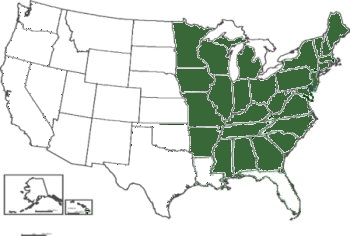| Botanical name: |
Lycopodium digitatum Dill. ex A. Braun |
| Common
name: |
fan clubmoss, running cedar |
| Synonomy: | | Diphasiastrum digitatum (Dill. ex A. Braun) Holub | | Diphasium complanatum (L.) Rothm. ssp. flabelliforme (Fernald) A. LŮve & D. LŮve | | Lycopodium complanatum L. var. flabelliforme Fernald | | Lycopodium flabelliforme (Fernald) Blanch. | | Lycopodium flabelliforme (Fernald) Blanch. var. ambiguum Victorin |
|
| Group: |
Lycopod |
| Family: |
Lycopodiaceae |
| Growth
Type: |
subshrub
forb/herb |
| Duration: |
perennial |
| Origin: |
native |
| Plant
height: |
under 6" |
| Foliage: |
numerous strobuli; evergreen stems are brancihing and flattened;
rhizomes found on the base of the forest floor rather than underground. |
| Flowering/fruiting time |
mature sporangia late July to September, spores formed in cool sites only |
| Habitat: |
bases of moist wooded areas, usually acidic soil |
| Range
in
New Jersey: |
statewide outside the central Pine Barrens, decreasing southward |
| Heritage ranking if any: |
n/a |
| Distribution: |
 |
| Misc.: |
In late season the spores from the spores are flammable,
"lycopodium powder". It has historically been used as a source of light
for photographer's flashes.
When finely dispersed near flame, it ignites.
|
|
|
Not sure what a word means? Use Answers.com:
|
|